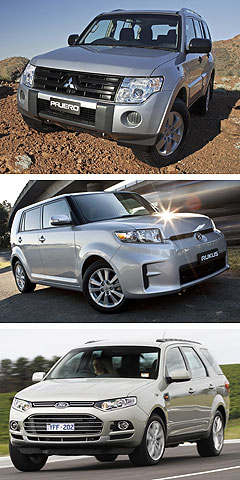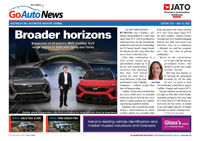News - General News - SafetyFour ANCAP stars for Toyota Rukus, Mitsu PajeroFrontal impact: The Mitsubishi Pajero received a four-star ANCAP safety rating, with leg protection again one of the issues highlighted. Toyota Rukus, Mitsubishi Pajero miss five stars as ANCAP regime develops past 20152 Jun 2011 By TERRY MARTIN TOYOTA’S Rukus compact wagon and the Mitsubishi Pajero SUV have both received four-star safety ratings from the Australasian New Car Assessment Program (ANCAP), falling below the maximum five-star result now anticipated with most new vehicles. The latest results from the authoritative independent crash-test organisation, which also include an extension of the previous five-star rating for Ford’s Territory SUV under the new SZ series, come as ANCAP is set to release an updated testing regime extending to 2016, up from the current 2011-2015 ‘roadmap’. Due in July, the updated roadmap will reflect emerging ‘safety assist technology’ (SAT), which is now part of the ANCAP assessment process. SAT currently includes equipment such as electronic stability control (ESC), head-protecting airbags for the front occupants and three-point seatbelts throughout – these are mandatory for achieving five stars, while extra points are awarded for other SAT features – and will toughen further with emergency brake assist and front seatbelt reminders becoming five-star requirements from 2013. From 2014, rear head-protecting airbags will be included, with seatbelt reminders for the rear compartment coming on stream in 2015.  From top: Mitsubishi Pajero, Toyota Rukus, Ford SZ Territory. From top: Mitsubishi Pajero, Toyota Rukus, Ford SZ Territory.Extra tests that assess whiplash protection and vehicle roof strength will also be introduced, from 2012 and 2014 respectively, while minimum standards for pedestrian protection also come into force next year. In releasing the latest results, which raised concerns over certain safety aspects of the Corolla-based Rukus as well as the relatively heavy-duty Pajero, ANCAP chairman Lauchlan McIntosh repeated the call for manufacturers and importers “to provide the safest vehicles possible for new-car buyers”. “ANCAP’s five-star-rated models are now available in every market segment,” he said. “Buyers should do their homework and seek out five-star vehicles to give their families and employees the best chance of avoiding the trauma of a serious crash.”The Rukus has a high level of standard safety equipment including dual front airbags, side airbags, head-protecting side curtain airbags, front seatbelt pretensioners, a full complement of three-point belts and, to help avoid a crash occurring, it has ESC and ABS brakes with electronic brake-force distribution. It scored 30.61 points out of 37, with full points (16 out of 16) in the side impact crash test, but lost ground in the frontal offset test, in which it scored 12.61 out of 16. In the offset test, the passenger compartment held its shape well but Mr McIntosh highlighted concerns about leg protection for the driver, which was assessed as ‘marginal’. Notes from the testers show that the steering column components were a potential source of injury for the driver’s right knee, while the fascia on each side of the glovebox was also a potential source of knee injury. Although Rukus is based on Corolla, Toyota’s big-selling small sedan scored a maximum five-star ANCAP rating when tested in 2008, scoring 33.63 out of 37. The Pajero has a similar level of standard safety equipment as the Rukus and scored 28.41 points out of 37 for its overall four-star result. It, too, scored maximum points for side impact protection – without a test actually being done – but managed only 11.41 points out of 16 in the offset crash test, with leg protection again one of the issues highlighted. “In the frontal offset crash test of the Pajero, leg protection for the driver was marginal and there were some concerns about deformation of the roof, driver’s door and the footwell,” Mr McIntosh said. Steering column components were identified as a potential source of injury for the Pajero driver’s knees, and although the passenger compartment held its shape reasonably well, the testers noted “there were signs of loss of integrity for the A-pillar and driver’s door, and rupture of the footwell”. The previous Pajero (2004-2007) also received a four-star rating. Ford’s SZ Territory was not crash tested but the SUV’s five-star rating was reaffirmed based on ANCAP tests in 2006 and technical information provided by Ford about the updated model. ANCAP says the SZ model can be expected to provide better chest protection and improved knee protection for the driver, the latter due to a knee airbag now being installed. With the world’s vehicle manufacturers placing an increasingly high value on five-star ratings under the international NCAP program – which has variations in assessment across different regions – ANCAP’s progressively tougher testing regime is designed to encourage manufacturers to build more safety into the design and specification of their vehicles. They also extend the current policy of providing consumers with information about “the availability of safety features and vehicle performance that go beyond regulatory requirements”. ANCAP business manager Nicholas Clarke told GoAuto this week that the roadmap had been subject to extensive discussion and negotiation with car-makers. “Industry were a bit concerned about the timing – having enough time to make modifications to their vehicles to meet the requirements – so we had extensive discussions about timing, but not such much about the technology,” he said. “I think they accept that technology is moving pretty quickly, and we’ve given them what we think is a good option of being able, with the additional SATs, to pick the technologies from a long list. “Some cars will get there quickly, others won’t. We’ll review it from time to time, and there’s also scope for the car companies to come back to us with other technologies as well.”  Read more26th of May 2011  Nissan Leaf tops EV safety ratingsNissan Leaf becomes first electric vehicle to achieve NCAP five-star rating16th of May 2011  Market insight: Keeping safety in sightChery J1 crash safety shortcomings highlight the benefits of ANCAP |
Click to shareGeneral News articlesResearch General News Motor industry news |
















Facebook Twitter Instagram